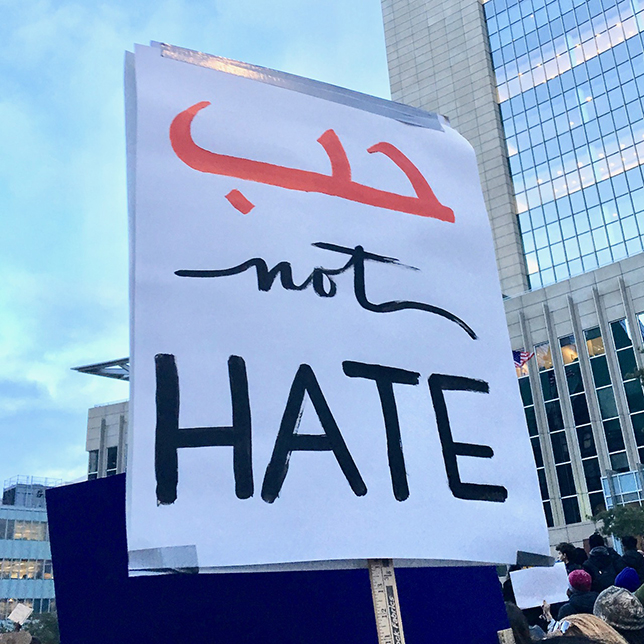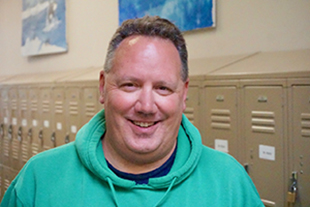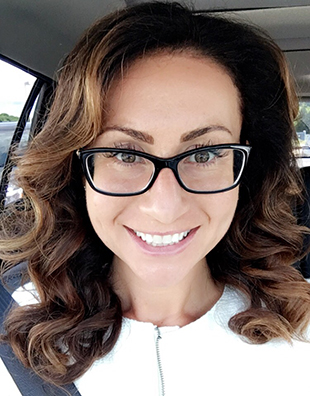Confronting Racism with Technology: One School's Story
Andy Charrier and Rebecca Bauer of Minnesota-based charter school Global Academy share their experiences tackling the hot topic of racism with technology.

A sign from a protest in Minneapolis used to promote positive messages in Global Academy's "Confronting Racism with Technology" program. The Arabic above says "Love."
Andy Charrier and Rebecca Bauer are educators at Global Academy, a public, K-8 charter school in Columbia Heights, MN, 10 minutes outside of downtown Minneapolis.
Inspired by Princeton University Assistant Professor Ruha Benjamin, they developed a session that utilizes technology to combat and confront racism.
Joined by their school director Helen Fisk and art teacher Marilyn Buckvold, Charrier and Bauer will participate in the ISTE poster session, “Confronting Racism with Technology: Grace in the Lion’s Den,” 7-8:30 p.m. Sunday, June 25.
THE Journal spoke with Charrier, who’s technology coordinator at Global Academy, and Bauer, who teaches first grade English language learners (ELL) and first grade reading and math at the school.
THE Journal: What made you pick this topic and idea of confronting racism with technology?
Andy Charrier: Last summer, we saw Ruja Benjamin speak. And that speech was amazing. She talked about all these different ways that technology is used to oppress people.

Andy Charrier
And we thought, we need to find different ways that technology can be used to teach about racism and oppression. And that’s really the origin. I just thought it was the kind of topic that needed to be shared.
Rebecca Bauer: We did a speech, a speaking presentation, and we filled a whole room full of people. People are looking for this information; they’re struggling to find out about it. We presented jointly; we did it together.
Charrier: It was timely. We wanted to find ways to give kids a voice and help them become comfortable talking about race and racism. They use photos as a form of communication, public speaking as a form of communication. It’s a way to better understanding race and racism in America. Martin Luther King Jr. once said, “Violence is a tool of the inarticulate.” We wanted to find ways to give the kids a voice.
The makeup of our school also has a lot to do with it: 70 percent of students are black, 90 percent are in poverty [free and reduced price lunch], and 50 percent are English language learners.
Bauer: It was the first time we did it at the school this year. Each student has their own iPad — they’re given that. They’re asked to take photos. One thing we used was an app called Seesaw. The students can have dialogue through that, and have parents get involved as well.
Charrier: The kids read stuff, higher-level material. They used iPads to sit down and listen to podcasts of college-level text. They say you can listen to reading three grade levels above your ability and still understand most of it.
We also showed them photos, a couple different kinds. One was showing diptychs that compared inequalities between people.
THE Journal: Have you presented this program outside of your school?
Charrier: No, but we’ve gotten lots of inquiries about this. We’re trying to put this together so that other educators can do this. We tried to do similar things with different groups of students.
The students come from different places, and they’re curious about people from different backgrounds. We have students from north Minneapolis, Brooklyn Park — they are really from all over the city. We have a lot of students whose native language is Arabic or Somali. There are a lot of native Spanish or Russian speakers. English might be their third language. They live in all different parts.

Rebecca Bauer
Bauer: We’re using our iPads to find new things and make them accessible to us. We looked into “Hidden Figures” and Katherine Johnson — there are hidden parts of history that we don’t know about because of racism.
The students love sharing, expressing themselves with photos. They do these different photography projects. They did put together a traveling photo show that went to a suburban high school. “These are pictures of my community,” they said. They were talking to other kids from different backgrounds.
THE Journal: Don’t you think people are afraid or hesitant to talk about race and racism in public?
Charrier: Oh yeah. Absolutely. That’s part of what motivated us. I feel like people are really careful about talking about race. They’re afraid to even have this discussion. Becky and I were willing to say, “We’re going to have this discussion.”
Bauer: We use technology to guide them to what they were thinking, feeling and curious about. But the idea of us giving them a lecture — that’s a misconception. We would have no credibility. We would have a hard time.
THE Journal: Do you think because Global Academy is a charter school, you have a little more freedom to do what you want?
Bauer: We do have the freedom to do this at our school. It is kinda different and challenging in that aspect. But to them, the experience of racism is real. It’s a part of their life that’s different.
These kids are very open. They’re curious about each other too. They really have a strong community together. Even some of the kids who wouldn’t speak to each other before — they were very open to each other. They’re really supportive, and the kids started sharing their own experiences. They validated one another and connected.
THE Journal: Are you looking forward to anything in particular at ISTE?
Bauer: I’m just excited to experience it. I’m curious to see what others are doing as well.
Charrier: I’ve done tech work in the schools for a long time. This is year 34 or 35 for me of doing tech work in schools.
At these conferences, it’s gone from, “How do you make your computers work?” to “How do you use something, how are you making use of this issue?”
I’ve had a look through the menu of programs — technology itself has almost become transparent to its purpose or its mission. That’s the No. 1 thing that struck me, five or six years ago. The geekdom is all gone. It’s all about learning.
THE Journal will be exhibiting at ISTE, June 25-28, in booth 754.